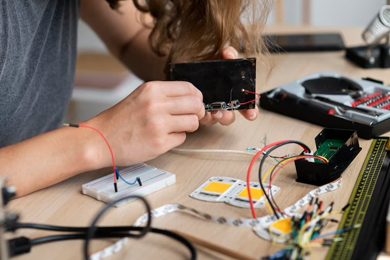This plan includes
- Limited free courses access
- Play & Pause Course Videos
- Video Recorded Lectures
- Learn on Mobile/PC/Tablet
- Quizzes and Real Projects
- Lifetime Course Certificate
- Email & Chat Support
What you'll learn?
- Program IoT devices using MicroPython (Python for Microcontrollers)
- Build IoT
- Sensor Interfacing with ESP8266: Light, Temperature and Humidity Sensing
- Actuator Interfacing with ESP8266
- Hardware (Electronics) Interfacing
- Use IoT Cloud to Upload Data (Collect)
- Use IoT Cloud to Apply Condition (Analysis)
- Act on IoT Data (Act)
Course Overview
Learn MicroPython from Scratch, No prior programming knowledge is required.
In this course, you will learn to Program ESP8266 with Micro Python Programming Language to
-
Access GPIOs (Blinking LEDs, Using Pull Up resistors, Interfacing Button)
-
Handle Interrupts
-
Use Inbuilt Analog to Digital Converter
-
Read Temperature, Light, Humidity Sensors (LDR, LM35, DHT)
-
Manipulate Environment with Actuators
-
Upload Data to IoT Cloud
-
Read Data from IoT Cloud
-
Control Devices using IoT Data
-
Implement Home Automation
This course is designed for beginners with very little or no programming knowledge. The course will start by identifying the differences between micropython and other programming languages targetted for low computing devices such as ESP8266 or ESP32 etc. Then you will learn to install the IDE for MIcroPython, in this course we have used uPyCraft, but you can your other IDEs as well. The target device for developing Internet of Things Devices (IoT) is ESP8266 - NODEMCU. You will learn about the various features of ESP8266, its pin configuration, its hardware capabilities, and other important parameters which are required to develop IoT devices.
Then the course will gradually gear up and you will be able to interface simple devices such as LED, Switches with ESP8266 NODEMCU. You will also learn the concept of interrupt and its importance in the field of embedded systems and IoT, you will also perform hands-on experiments on interrupts.
Now the course will further gain its pace and you will come across analog to digital converter and you will learn to interface analog sensors such as Light-dependent Resistors (LDR), LM35 Temperature sensor, with NODEMCU and get values from these sensors.
Pulse width modulation (PWM) is a very important concept which offers many industrial applications, we will learn to generate to PWM wave with variable duty cycle and variable frequency, we will also learn to control the brightness of LED using PWM.
The next concept is WEBREPL where we will learn to send codes or other information to our NODEMCU wirelessly without connecting NODEMCU to your PC. This opens many application areas.
Here we will also learn about Relays using which we will able to control AC appliances like Bulb or Fan etc. We will also explore DHT11 which is one more sensor to read the temperature, it is also used to read humidity.
From here we will move towards developing IoT devices. First, you will learn to connect your device with Access Point, then you will learn about the cloud Platform "ThingSpeak". here you will learn to create an account on ThingSpeak, create channels to upload data, upload data using a computer browser to your thingspeak channel. Get data from the cloud to your NODEMCU device.
Now you will develop a project Home Automation using your ESP8266 NODEMCU. In this project you will learn to send temperature data to the cloud, the cloud will check the temperature data and will send a command to other distant located devices.
Conclusion: This course is for beginners and it will give you a good start to your journey of Internet of Things, and in this process, you will learn a programming Language "MicroPython", You will learn to interface Sensors, and actuators (hardware) with your ESP8266 device.
Happy Learning !!
Pre-requisites
- Curious and Ready to Learn
Target Audience
- Beginner with little or no prior knowledge of electronics & programming curious about designing IoT systems themselves
Curriculum 44 Lectures 04:41:48
Section 1 : Expectations from the course
Section 2 : Hello MicroPython and ESP8266
- Lecture 1 :
- Overview of MicroPython
- Lecture 2 :
- What is ESP8266 ?
- Lecture 3 :
- Components on ESP8266
- Lecture 4 :
- Setting Up MicroPython and ESP8266
Section 3 : GPIOs and Interrupts : LEDs, Pull Up Resistors, Switch, Interrupts
- Lecture 1 :
- LED Interfacing: Learn to write the first code to blink LED and More
- Lecture 2 :
- Pull Up resistor and Button: Enable Pull Up resistor & Interface Button
- Lecture 3 :
- Interface Switch and LED
- Lecture 4 :
- What are Interrupts?
- Lecture 5 :
- MicroPython Program to Handle Single Interrupt
- Lecture 6 :
- Writing Multiple Interrupts
Section 4 : ADC Light and Temperature Sensors
- Lecture 1 :
- Analog to Digital Conversion
- Lecture 2 :
- Reading Inbuilt ADC of ESP8266
- Lecture 3 :
- Interface LDR: Learn LDR and Interface LDR with ESP8266
- Lecture 4 :
- Temperature Sensing: What is LM35?
- Lecture 5 :
- Interface LM35 with ESP8266
- Lecture 6 :
- MicroPython Functions: LM35 Function
Section 5 : Pulse Width Modulation (PWM): Learn PWM, PWM Generation and control using PWM
- Lecture 1 :
- What is Pulse Width Modulation (PWM)
- Lecture 2 :
- PWM Generation
- Lecture 3 :
- Controlling Brightness of LED using PWM
Section 6 : WEBREPL: Program NODEMCU With Wireless connection
- Lecture 1 :
- WEBREPL
Section 7 : Relay - Electromechanical Switch
- Lecture 1 :
- What is Relay Actuator
- Lecture 2 :
- Bulb Control: Interface Bulb with ESP8266 using Relay and other Electronics
Section 8 : Temperature and Humidity Sensor : DHT Sensors
- Lecture 1 :
- DHT Sensors: DHT11 and DHT22
- Lecture 2 :
- Read Temperature and Humidity using DHT11 Sensor
Section 9 : Internet of Things - (IoT)
- Lecture 1 :
- What is Internet of Things (IoT) and What are its Application Domains
- Lecture 2 :
- IoT Technology Stack: Components of IoT
- Lecture 3 :
- ESP8266 is able to connect to WiFI Access Point (HotSpot)
Section 10 : The Iot Cloud Platform - ThingSpeak
- Lecture 1 :
- Introduction to ThingSpeak Cloud Platform from Mathworks
- Lecture 2 :
- Creating ThingSpeak Account
- Lecture 3 :
- Create ThingSpeak Channel to Upload Data
- Lecture 4 :
- Channel Dash Board: Navigating Through ThingSpeak Channel
- Lecture 5 :
- Upload data to ThingSpeak Channel using Computer Browser
Section 11 : ESP8266 Talks to ThingSpeak IoT Cloud
- Lecture 1 :
- Program ESP8266 to Upload Data to ThingSpeak IoT Cloud
- Lecture 2 :
- Program ESP8266 to Upload Temperature & Humidity Data (DHT) to IoT Cloud
- Lecture 3 :
- Program ESP8266 to Read data from IoT Cloud
- Lecture 4 :
- Implement IoT Close Loop
Section 12 : Home Automation
- Lecture 1 :
- Scenario Explanation
- Lecture 2 :
- Program ESP8266 to Upload Temperature data to IoT Cloud
- Lecture 3 :
- Create TalkBack Command Queue
- Lecture 4 :
- Bulb Control: Program ESP8266 to receive commands from TalkBack Command Queue
- Lecture 5 :
- Making web requests using ThingHTTP Service to update TalkBack Command
- Lecture 6 :
- React: Applying Conditions on Channel Data and Taking Actions
- Lecture 7 :
- Home Automation: Demonstration
Our learners work at
Frequently Asked Questions
How do i access the course after purchase?
It's simple. When you sign up, you'll immediately have unlimited viewing of thousands of expert courses, paths to guide your learning, tools to measure your skills and hands-on resources like exercise files. There’s no limit on what you can learn and you can cancel at any time.Are these video based online self-learning courses?
Yes. All of the courses comes with online video based lectures created by certified instructors. Instructors have crafted these courses with a blend of high quality interactive videos, lectures, quizzes & real world projects to give you an indepth knowledge about the topic.Can i play & pause the course as per my convenience?
Yes absolutely & thats one of the advantage of self-paced courses. You can anytime pause or resume the course & come back & forth from one lecture to another lecture, play the videos mulitple times & so on.How do i contact the instructor for any doubts or questions?
Most of these courses have general questions & answers already covered within the course lectures. However, if you need any further help from the instructor, you can use the inbuilt Chat with Instructor option to send a message to an instructor & they will reply you within 24 hours. You can ask as many questions as you want.Do i need a pc to access the course or can i do it on mobile & tablet as well?
Brilliant question? Isn't it? You can access the courses on any device like PC, Mobile, Tablet & even on a smart tv. For mobile & a tablet you can download the Learnfly android or an iOS app. If mobile app is not available in your country, you can access the course directly by visting our website, its fully mobile friendly.Do i get any certificate for the courses?
Yes. Once you complete any course on our platform along with provided assessments by the instructor, you will be eligble to get certificate of course completion.
For how long can i access my course on the platform?
You require an active subscription to access courses on our platform. If your subscription is active, you can access any course on our platform with no restrictions.Is there any free trial?
Currently, we do not offer any free trial.Can i cancel anytime?
Yes, you can cancel your subscription at any time. Your subscription will auto-renew until you cancel, but why would you want to?
Instructor

3832 Course Views
4 Courses



 Tech & IT
Tech & IT
 Business
Business
 Coding & Developer
Coding & Developer
 Finance & Accounting
Finance & Accounting
 Academics
Academics
 Office Applications
Office Applications
 Art & Design
Art & Design
 Marketing
Marketing
 Health & Wellness
Health & Wellness
 Sounds & Music
Sounds & Music
 Lifestyle
Lifestyle
 Photography
Photography

















